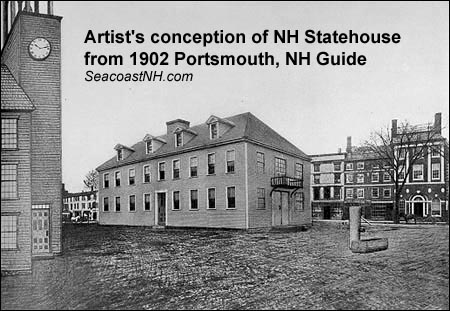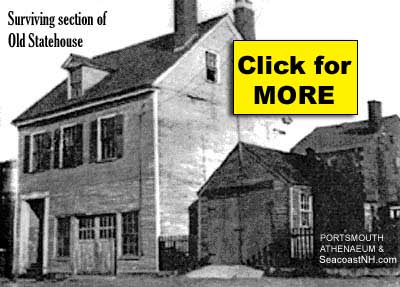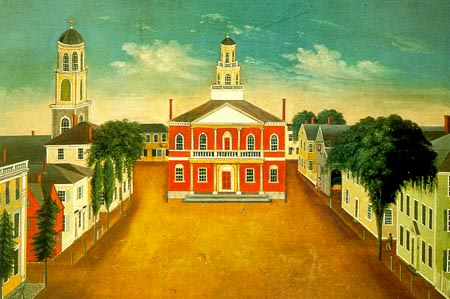|
FRESH STUFF DAILY |
|
|
||
|
|
||
|
|
||
|
SEE ALL SIGNED BOOKS by J. Dennis Robinson click here |
||
Again they tried to move the battered 1760-era statehouse. This time it was an accident, a trucker thought it was a trailer full of junk. Others say it is a trailer full of treasure -- the last timbers of New Hampshire's provincial court house. We go back to the day it was first trucked away in 1836.
PLEASE READ: Original Statehouse Timeline The Old NH State House Trucked Off -- Four Times People have been dragging Portsmouth’s Old Statehouse around from one place to another for 180 years. Few seem to care. For nearly two decades the rotting timbers, joists and beams of the venerable 1758 structure have been lying in a trailer truck in Concord, NH. When a very dumb trucker tried to haul the old relic to the dump recently, the dismembered building made headlines once again. The driver, as it turns out, was in the wrong spot looking for industrial debris. He did not notice that the battered trailer had flat tires, no warning lights and no license plates. He only dragged the trailer a few feet off its cement flooring before giving up and heading for the hills. Turns out It was the best publicity the old wreck has had in years.
There are lots of reasons why the statehouse is in a trailer. It is, for one, just a piece of the old building. Somewhere between one-third and one-eighth of the provincial statehouse innards survive, depending on which scholar you ask. The entire interior, exterior, roof, granite foundation stones, furnishings and ornamental detail are gone. The structure was a wreck in 1836 when it stood smack in the middle of Portsmouth’s Market Square (then called The Parade), directly between the Portsmouth Athenaeum and the North Church. The town appropriated $700 for its removal in 1836 and Capt. Israel Marden carried part of it away. That part has been moved twice since, and the ride is apparently not over. Attempts are still underway to reconstruct the Statehouse in Portsmouth and Governor John Lynch has located $250,000 in federal funds to study the idea. No one knows where the other two-thirds of the building went. The surviving chunk was moved a few blocks to 47 Court Street where it was converted into a two-story house. That piece was later moved to Strawbery Banke in 1969. By that time it was owned by the state of New Hampshire and being used as a storage warehouse for the NH Liquor Commission. The idea to rebuild the Old Statehouse was first proposed in 1935 when the National Park Service briefly considered turning the Portsmouth waterfront into a state park. The idea was revived in the original plan to create Strawbery Banke starting in 1958. But by the time the surviving piece arrived at The Banke, money was tight and the board of directors had 30 other largely dilapidated buildings to attend to. Museum trustees held heated debates over whether to proceed with the reconstruction. CONTINUE with OLD NH STATEHOUSE
Then in 1970 a University of New Hampshire grad student theorized that the rotting building was not part of the Old Statehouse at all. He was wrong, but doubts created by his report slowed the reconstruction for another decade. By the time scholars had proven it was indeed part of the original building, Strawbery Banke was headed in a wholly different direction with its museum plan. In 1988 a New Hampshire bill appropriated $1.75 million for the reconstruction project, but it eventually failed. So in 1990 the state of NH paid $50,000 to have the building disassembled and stored in a trailer and moved to Concord where it sits today. Portsmouth newspaper editor Charles Brewster was the last known person to walk through the Old Statehouse just minutes before it was demolished in November 1836. For Brewster the building was a hallowed place. Standing in the center of Congress Street, it had survived all three downtown fires. By the time he stepped through the propped open doors, the building had been stripped to its framed timbers – much like today. About the building shell, he wrote, "its vacant windows seem glaring most beseechingly upon passersby." Brewster’s farewell essay, recently rediscovered, offers a rare look at the first New Hampshire statehouse. Unfortunately for us, Brewster was moved to a poetic rapture as he watched the pre-Revolutionary halls of justice being dismantled. He offered no clear description of the building that his readers already knew so well. So instead of journalistic detail, we are left with the author’s emotional response. "Am I to sink, unwept, unhonored and unsung?" Brewster wrote in 1836, as if listening to the dying words of the old statehouse. "Once the greatest and most honored fabric of the granite State: am I to pass off at the blow of an ivory hammer, and even my foundations be treated with contempt?" CONTINUE with OLD NH STATEHOUSE
Brewster was writing a eulogy rather than a description. He visited he said, out of pity for the "frail tenement". Like a doctor visiting a dying patient, he came only with kind words, "not with the hope of resuscitating it from its sinking disease". Yet nearly two centuries later, some historians cling to a hope that the bones will rise again. In 1967, in an appeal to preserve the statehouse, attorney David Engel told New Hampshire officials that "this may be the last opportunity we get to save this building which is in deteriorating condition". Forty years later Engel and members of Portsmouth’s Save the Statehouse committee are still trying. For some, the statehouse symbolizes the critical era in history when New Hampshire transformed itself from a colonial colony to a sovereign state. Built under two royal British governors, the statehouse was the starting point for an early protest march against the Stamp Act. At the height of the Revolution, after Gov. John Wentworth had been driven from his home town forever, locals gathered to hear the Declaration of Independence read from the second floor balcony. Later George Washington reportedly waved to Portsmouth citizens from the same spot. By then, the state capital had already moved to nearby Exeter, and in 1819 to Concord. No images of the building survive. An artist’s sketch first appeared in a 1902 tourist guide to Portsmouth. That drawing was created "according to the testimony of many old people, who can remember it distinctly." But those old people had certainly seen the building in its declining years, after its adaptation to a Greek-revival style, with no stately cupola and with most of its ornamentation removed. It was not until 1987, when the state of New Hampshire issued a detailed report that a new conceptual sketch showed the likely building at the height of its grandeur. What’s left of that grandeur hunkers today inside a cold steel trailer, slowly returning to dust. Charles Brewster never imagined a reconstructed Old Statehouse. Such an idea was unthinkable before the rise of tourism. He was simply saying goodbye to an old friend. Then suddenly, his visit was cut short by the return of the wrecking crew ready to finish their job. In a burst of patriotic emotion, the reporter concluded his 1836 obituary: "We were going on administering other words of consolation to the old State House, but at this moment the clock struck one and as the undertaker we found standing with tools in hand waiting for us to depart, the bell took our last words from our lips, and rang its changes until we were out of hearing - "Innovation-In-no-va-tion! Sic transit gloria mundi!" SOURCE NOTE: Charles Brewster quotations are from Portsmouth & Great Falls Journal of Literature & Politics Saturday, November 5, 1836. This article was rediscovered by historian Richard Winslow, who first found a reference to it in an 1878 letter to Brewster's son and heir Lewis Brewster. Copyright © 2006 by J. Dennis Robinson. All rights reserved. SeacoastNH.com Please visit these SeacoastNH.com ad partners.
News about Portsmouth from Fosters.com |
| Saturday, April 20, 2024 |


|
Copyright ® 1996-2020 SeacoastNH.com. All rights reserved. Privacy Statement
Site maintained by ad-cetera graphics

 HISTORY
HISTORY






















